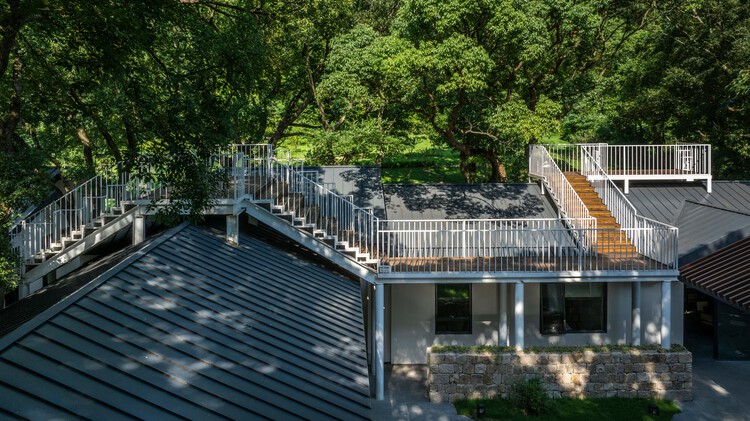
-
Architects: Zen-In Architects
- Area: 865 m²
- Year: 2024
-
Photographs:Weiqi Jin
-
Lead Architects: Shengzhe Shen

Text description provided by the architects. The Healing Hills Villa was originally a deserted courtyard atop a small hill, surrounded by lush green trees with twisting roots, making it feel as if it were protected by 48 old camphor trees. The transformation of the architectural space relies entirely on the relationship with the trees—neither encroaching upon them nor isolating them. There are three strategies. First, the scattered buildings were integrated into three courtyards, each relatively independent yet closely connected. Second, the boundaries between the built environment and the natural surroundings were blurred, allowing trees to coexist within the courtyards and the courtyards to extend into the trees, creating a seamless interaction between architecture and nature. Finally, new functions were infused based on the distinct characteristics of each space, creating a bridge of experience between the "artificial" and the "natural".


There are 6 relationships between architecture and 48 old camphor trees: Encircled, Encirclement, Retreat, Gaze, Impaction, Contrast. Architecture draws from and merges with nature, with the design combining spatial elements with the natural forms found in traditional Chinese painting and extracts 4 key elements.


"Rolling Mountain" — Undulating Roof
Based on the original building layout, integrate the scattered roofs and, taking functional needs into account, delineate the functional zones, ultimately forming a three-courtyard layout that unfolds around the trees.


"Stacked Platform" — Expansive Platform
With the undulating terrain of the Healing Hill Villa site, the platforms are stacked at varying heights, "gazing" at each other between the trees, creating a landscape space and activity area that offers diverse spatial experiences.



"Floating Clouds" —— Surrounding Bridge
The Bridge connects the three courtyard spaces, enriching the experience of wandering. Serving as a daily weather-protected walkway, a three-dimensional landscape passage, and a space for parent-child activities.


"Towering Stones" — Inserted Block
Emphasize important nodes as visual focal points and landmarks, making them standout features within the space.


Utilizing the topographical conditions, the Front Courtyard and the Middle Courtyard, located near the main road, will serve as public activity areas. The Back Courtyard, close to the pond and in a tranquil environment, will be designated for guest rooms. The Front Courtyard accommodates functions such as reception, a breakfast area, and a leisure coffee zone, allowing for independent operation.


Due to the leaning tree on the east side of the Breakfast Restaurant, the building was demolished and reconstructed to avoid it, respecting its uniqueness. The Middle Courtyard features supporting services such as a restaurant and kitchen. Maximize the opening of the walls on the north and south sides of the Main Restaurant to minimize visual barriers. The Back Courtyard primarily caters to the daily activities of guests and visitors. By removing the tall walls that block the trees, the platform extends around the trees, bringing the tree scenery.


Eight uniquely laid-out rooms offer distinctive views, Interior decor is simplified, using "nature" to enhance the space. The Bridge connects three courtyards, weaves through the buildings and trees, serving not only as connectors of space but also as "bridge" between people and architecture, as well as between people and nature. On the east and west sides of the Healing Hills Villa, there are Heartwarming Creation Workshop and Hollow Coffee as supporting spaces.



































